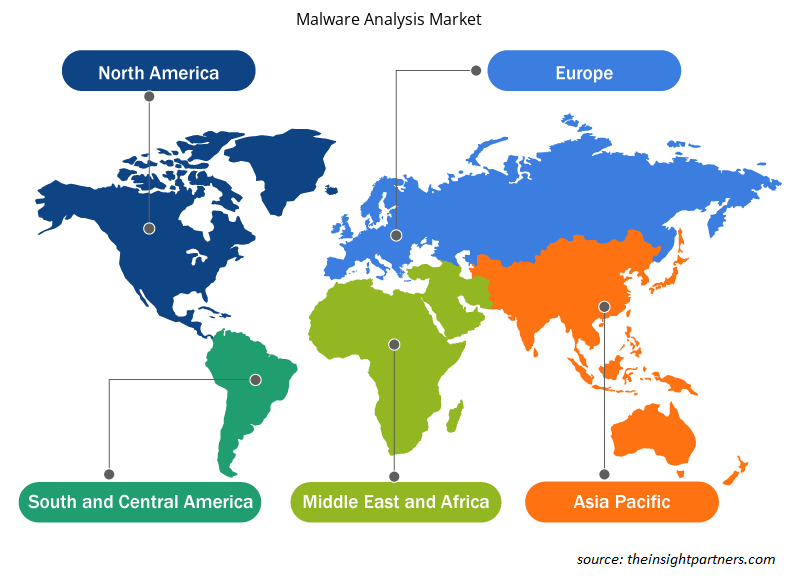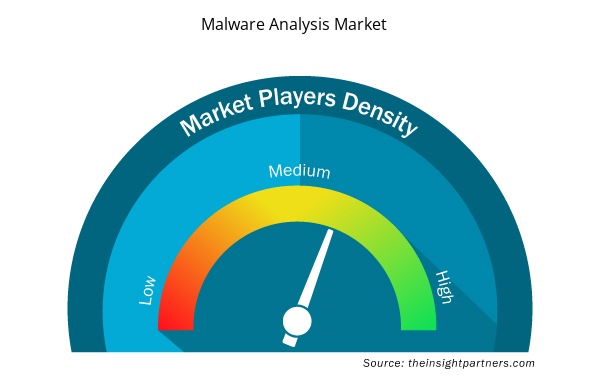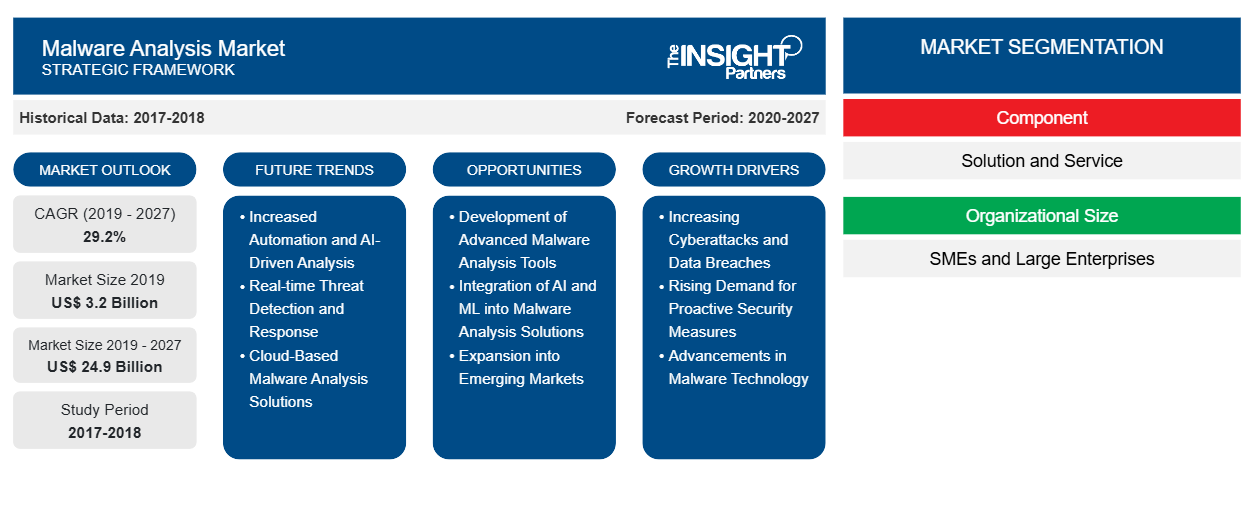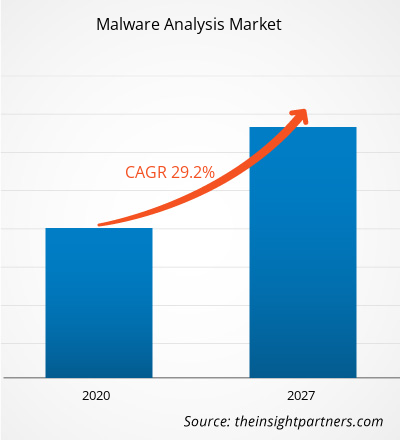[Forschungsbericht] Der Markt für Malware-Analyse soll von 3.204,4 Millionen US-Dollar im Jahr 2019 auf 24.898,3 Millionen US-Dollar im Jahr 2027 wachsen; von 2019 bis 2027 wird mit einer durchschnittlichen jährlichen Wachstumsrate von 29,2 % gerechnet.
Zunehmende Regierungsinitiativen tragen zum Wachstum des Marktes bei. Regierungen in mehreren Ländern weltweit ergreifen Initiativen, um die Einführung von Malware-Analysetools durch Unternehmen zu unterstützen. So startete die indische Regierung 2017 ihr Cyber Swachhta Kendra, ein Botnet-Reinigungs- und Malware-Analysezentrum. Das Zentrum soll Botnet-Infektionen im Land erkennen und weitere Infektionen verhindern, indem es die Systeme der Endbenutzer benachrichtigt, säubert und sichert. Außerdem wurde im März 2019 vom Europäischen Parlament ein neues EU-Cybersicherheitsgesetz verabschiedet. Die neue Verordnung schafft einen EU-Zertifizierungsrahmen für Cybersicherheit. Dieser Rahmen soll die Transparenz der Cybersicherheitsgarantie von IKT-Produkten, -Diensten und -Prozessen erhöhen und so das Vertrauen stärken und Endbenutzern helfen, gut informierte Entscheidungen zu treffen. Ein weiterer wichtiger Grund für den Rahmen ist, die Zunahme widersprüchlicher oder überlappender nationaler Zertifizierungen zu vermeiden und dadurch Kosten zu senken. Gemäß der Verordnung ist die EU befugt, europäische Cybersicherheits-Zertifizierungssysteme, die von ENISA festgelegt werden, für bestimmte Gruppen von IKT-Produkten, -Diensten und -Prozessen zu übernehmen. Die Systeme könnten beispielsweise IKT-Produkte, -Dienste und -Prozesse abdecken, die in Flugzeugen, Autos, medizinischen Geräten, Kraftwerken sowie internetfähigen Verbrauchergeräten verwendet werden.
Im Jahr 2018 hat die Monetary Authority of Singapore (MAS) ein Cybersicherheits-Förderprogramm in Höhe von 22 Millionen US-Dollar aufgelegt, um die Finanzinstitute des Landes dabei zu unterstützen, ihre Cyber-Resilienz zu stärken und lokale Talente durch Cybersicherheits-Schulungsprogramme wie Malware-Analyse, Sicherheitsoperationen, Computerforensik, Überwachung von Cyberbedrohungen und Suche nach Cyberbedrohungen weiterzubilden. Solche Regierungsinitiativen dürften das Wachstum des Malware-Analysemarktes fördern.
Passen Sie diesen Bericht Ihren Anforderungen an
Sie erhalten kostenlose Anpassungen an jedem Bericht, einschließlich Teilen dieses Berichts oder einer Analyse auf Länderebene, eines Excel-Datenpakets sowie tolle Angebote und Rabatte für Start-ups und Universitäten.
- Holen Sie sich die wichtigsten Markttrends aus diesem Bericht.Dieses KOSTENLOSE Beispiel umfasst eine Datenanalyse von Markttrends bis hin zu Schätzungen und Prognosen.
Markteinblicke–
Markt für Malware-Analyse
Zunehmende Nutzung digitaler Lösungen in verschiedenen Branchen
Die Implementierung digitaler Lösungen nimmt in verschiedenen Branchen zu, darunter Fertigung, Gesundheitswesen, Automobilindustrie, BFSI, Medien und Unterhaltung sowie Einzelhandel. Diese Branchen profitieren zunehmend von der digitalen Transformation. Analysen ermöglichen es ihnen, Kunden besser zu verstehen und zu bedienen. Darüber hinaus führt der Zugriff auf Echtzeitinformationen zu effizienteren Entscheidungen. Die Automatisierung von Geschäftsabläufen ermöglicht es ihnen, die Produktivität zu steigern. So haben beispielsweise Automobilhersteller ihren Herstellungsprozess durch den Einsatz von Robotern revolutioniert; und Fluggesellschaften sind durch Echtzeitinformationen über Angebot und Nachfrage zu einer kompetenten Preisgestaltung geworden. Darüber hinaus haben Einzelhandelsunternehmen mit robusten digitalen Fähigkeiten nahtlose Omnichannel-Umgebungen entwickelt. Auch die Gesundheitsbranche hat sich durch elektronische Gesundheitsakten (EHR), digitale Tools zur Überwachung der Vitalfunktionen von Patienten sowie virtuelle Konsultationen zwischen Patienten und Ärzten modernisiert. Mit der zunehmenden Einführung digitaler Technologien wie IoT, Big Data und KI in Unternehmen und der Gesellschaft insgesamt hat die zunehmende Vernetzung von allem jedoch Herausforderungen in Bezug auf Compliance, Sicherheit und Datenschutz geschaffen. Die Bewältigung neuer Malware-Trends treibt daher die Einführung von Malware-Analysetools voran.
Komponentenbasierte Erkenntnisse
Basierend auf Komponenten ist der Markt für Malware-Analyse in Lösungen und Dienste segmentiert. Das Lösungssegment hatte 2018 den größten Marktanteil.
Erkenntnisse auf Basis der Unternehmensgröße
Basierend auf der Unternehmensgröße ist der Markt für Malware-Analyse in Großunternehmen sowie kleine und mittlere Unternehmen segmentiert. Das Segment der Großunternehmen hatte 2018 den größten Marktanteil.
Die Akteure auf dem Markt für Malware-Analyse konzentrieren sich hauptsächlich auf die Entwicklung fortschrittlicher und effizienter Produkte.
- Im Jahr 2019 kündigten Google Cloud und Palo Alto Networks neue Lösungen an, die den Kunden mehr Sicherheit bieten sollen. Die beiden Unternehmen werden zusammenarbeiten, um neue Angebote auf den Markt zu bringen und mehrere Dienste von Palo Alto Networks auf Google Cloud auszuführen.
- Im Jahr 2019 kündigte Kaspersky in Partnerschaft mit CyberSecurity Malaysia sein erstes Transparenzzentrum im Asien-Pazifik-Raum an. Es soll den Partnern des Unternehmens und staatlichen Interessenvertretern als vertrauenswürdige Einrichtung dienen, in der sie den Quellcode der Lösungen von Kaspersky überprüfen können.
Regionale Einblicke in den Markt für Malware-Analyse
Die regionalen Trends und Faktoren, die den Markt für Malware-Analysen im Prognosezeitraum beeinflussen, wurden von den Analysten von Insight Partners ausführlich erläutert. In diesem Abschnitt werden auch die Marktsegmente und die Geografie von Malware-Analysen in Nordamerika, Europa, im asiatisch-pazifischen Raum, im Nahen Osten und Afrika sowie in Süd- und Mittelamerika erörtert.

- Erhalten Sie regionale Daten zum Malware-Analyse-Markt
Umfang des Marktberichts zur Malware-Analyse
| Berichtsattribut | Details |
|---|---|
| Marktgröße im Jahr 2019 | 3,2 Milliarden US-Dollar |
| Marktgröße bis 2027 | 24,9 Milliarden US-Dollar |
| Globale CAGR (2019 - 2027) | 29,2 % |
| Historische Daten | 2017-2018 |
| Prognosezeitraum | 2020–2027 |
| Abgedeckte Segmente | Nach Komponente
|
| Abgedeckte Regionen und Länder | Nordamerika
|
| Marktführer und wichtige Unternehmensprofile |
|
Marktteilnehmerdichte: Der Einfluss auf die Geschäftsdynamik
Der Markt für Malware-Analysen wächst rasant. Dies wird durch die steigende Nachfrage der Endnutzer aufgrund von Faktoren wie sich entwickelnden Verbraucherpräferenzen, technologischen Fortschritten und einem größeren Bewusstsein für die Vorteile des Produkts vorangetrieben. Mit der steigenden Nachfrage erweitern Unternehmen ihr Angebot, entwickeln Innovationen, um die Bedürfnisse der Verbraucher zu erfüllen, und nutzen neue Trends, was das Marktwachstum weiter ankurbelt.
Die Marktteilnehmerdichte bezieht sich auf die Verteilung von Firmen oder Unternehmen, die in einem bestimmten Markt oder einer bestimmten Branche tätig sind. Sie gibt an, wie viele Wettbewerber (Marktteilnehmer) in einem bestimmten Marktraum im Verhältnis zu seiner Größe oder seinem gesamten Marktwert präsent sind.
Die wichtigsten auf dem Markt für Malware-Analysen tätigen Unternehmen sind:
- AT&T Inc.
- AO Kaspersky Lab
- Broadcom, Inc.
- Cisco Systems, Inc.
- CrowdStrike Holdings Inc
Haftungsausschluss : Die oben aufgeführten Unternehmen sind nicht in einer bestimmten Reihenfolge aufgeführt.

- Überblick über die wichtigsten Akteure auf dem Malware-Analyse-Markt
Der Markt für Malware-Analyse wurde wie folgt segmentiert:
Markt für Malware-Analyse – nach Komponenten
- Lösung
- Service
Markt für Malware-Analyse – nach Unternehmensgröße
- KMU
- Große Unternehmen
Markt für Malware-Analyse – nach Bereitstellung
- Vor Ort
- Cloudbasiert
Markt für Malware-Analyse – nach Endbenutzerbranche
- BFSI
- Regierung
- Gesundheitspflege
- IT und Telekommunikation
- Herstellung
- Sonstiges
Markt für Malware-Analyse – nach Geografie
- Nordamerika
- UNS
- Kanada
- Mexiko
- Europa
- Frankreich
- Deutschland
- Italien
- Russland
- Vereinigtes Königreich
- Restliches Europa
- Asien-Pazifik (APAC)
- Japan
- China
- Australien
- Indien
- Südkorea
- Restlicher Asien-Pazifik-Raum
- Naher Osten und Afrika (MEA)
- Saudi-Arabien
- Vereinigte Arabische Emirate
- Südafrika
- Rest von MEA
- Südamerika (SAM)
- Brasilien
- Argentinien
- Rest von SAM
Markt für Malware-Analyse – Firmenprofile
- AO Kaspersky Lab
- AT&T
- Broadcom
- Cisco
- CrowdStrike
- FireEye
- Fortinet
- Palo Alto-Netzwerke
- Qualys
- Trend Micro
- Historische Analyse (2 Jahre), Basisjahr, Prognose (7 Jahre) mit CAGR
- PEST- und SWOT-Analyse
- Marktgröße Wert/Volumen – Global, Regional, Land
- Branche und Wettbewerbsumfeld
- Excel-Datensatz


- Truck Refrigeration Market
- Bio-Based Ethylene Market
- Glycomics Market
- Quantitative Structure-Activity Relationship (QSAR) Market
- Hydrocephalus Shunts Market
- Fish Protein Hydrolysate Market
- Airline Ancillary Services Market
- Medical Enzyme Technology Market
- Arterial Blood Gas Kits Market
- Energy Recovery Ventilator Market

Report Coverage
Revenue forecast, Company Analysis, Industry landscape, Growth factors, and Trends

Segment Covered
This text is related
to segments covered.

Regional Scope
North America, Europe, Asia Pacific, Middle East & Africa, South & Central America

Country Scope
This text is related
to country scope.
Häufig gestellte Fragen
BFSI dominated the malware analysis market in 2018. BFSI organizations are more vulnerable to cyber-attacks due to huge financial and personal data of customers on systems. In this sector, a massive amount of sensitive data is generated and exchanged daily. With the growing volume of data, end-points are also increasing at a rapid pace and monitoring these end points poses a huge challenge for this sector.
In past few years, cybercrime in the APAC region has grown to be a greater risk as compared to other leading regions. This is majorly because of rapidly increasing connectivity and rushing pace of digital transformation in the region, resulting into sharpening concern for technological threats among the businesses.
Rapid adoption of digitalization among diverse industries, implementation of IoT, and high adoption of connected devices offers lucrative opportunities to the market players. Also, rising trend of BYOD is another significant market opportunity.
Trends and growth analysis reports related to Technology, Media and Telecommunications : READ MORE..
The List of Companies - Malware Analysis Market
- AT&T Inc.
- AO Kaspersky Lab
- Broadcom, Inc.
- Cisco Systems, Inc.
- CrowdStrike Holdings Inc
- FireEye, Inc.
- Fortinet, Inc.
- Palo Alto Networks, Inc.
- Qualys, Inc.
- Trend Micro Incorporated, among others.
The Insight Partners performs research in 4 major stages: Data Collection & Secondary Research, Primary Research, Data Analysis and Data Triangulation & Final Review.
- Data Collection and Secondary Research:
As a market research and consulting firm operating from a decade, we have published and advised several client across the globe. First step for any study will start with an assessment of currently available data and insights from existing reports. Further, historical and current market information is collected from Investor Presentations, Annual Reports, SEC Filings, etc., and other information related to company’s performance and market positioning are gathered from Paid Databases (Factiva, Hoovers, and Reuters) and various other publications available in public domain.
Several associations trade associates, technical forums, institutes, societies and organization are accessed to gain technical as well as market related insights through their publications such as research papers, blogs and press releases related to the studies are referred to get cues about the market. Further, white papers, journals, magazines, and other news articles published in last 3 years are scrutinized and analyzed to understand the current market trends.
- Primary Research:
The primarily interview analysis comprise of data obtained from industry participants interview and answers to survey questions gathered by in-house primary team.
For primary research, interviews are conducted with industry experts/CEOs/Marketing Managers/VPs/Subject Matter Experts from both demand and supply side to get a 360-degree view of the market. The primary team conducts several interviews based on the complexity of the markets to understand the various market trends and dynamics which makes research more credible and precise.
A typical research interview fulfils the following functions:
- Provides first-hand information on the market size, market trends, growth trends, competitive landscape, and outlook
- Validates and strengthens in-house secondary research findings
- Develops the analysis team’s expertise and market understanding
Primary research involves email interactions and telephone interviews for each market, category, segment, and sub-segment across geographies. The participants who typically take part in such a process include, but are not limited to:
- Industry participants: VPs, business development managers, market intelligence managers and national sales managers
- Outside experts: Valuation experts, research analysts and key opinion leaders specializing in the electronics and semiconductor industry.
Below is the breakup of our primary respondents by company, designation, and region:

Once we receive the confirmation from primary research sources or primary respondents, we finalize the base year market estimation and forecast the data as per the macroeconomic and microeconomic factors assessed during data collection.
- Data Analysis:
Once data is validated through both secondary as well as primary respondents, we finalize the market estimations by hypothesis formulation and factor analysis at regional and country level.
- Macro-Economic Factor Analysis:
We analyse macroeconomic indicators such the gross domestic product (GDP), increase in the demand for goods and services across industries, technological advancement, regional economic growth, governmental policies, the influence of COVID-19, PEST analysis, and other aspects. This analysis aids in setting benchmarks for various nations/regions and approximating market splits. Additionally, the general trend of the aforementioned components aid in determining the market's development possibilities.
- Country Level Data:
Various factors that are especially aligned to the country are taken into account to determine the market size for a certain area and country, including the presence of vendors, such as headquarters and offices, the country's GDP, demand patterns, and industry growth. To comprehend the market dynamics for the nation, a number of growth variables, inhibitors, application areas, and current market trends are researched. The aforementioned elements aid in determining the country's overall market's growth potential.
- Company Profile:
The “Table of Contents” is formulated by listing and analyzing more than 25 - 30 companies operating in the market ecosystem across geographies. However, we profile only 10 companies as a standard practice in our syndicate reports. These 10 companies comprise leading, emerging, and regional players. Nonetheless, our analysis is not restricted to the 10 listed companies, we also analyze other companies present in the market to develop a holistic view and understand the prevailing trends. The “Company Profiles” section in the report covers key facts, business description, products & services, financial information, SWOT analysis, and key developments. The financial information presented is extracted from the annual reports and official documents of the publicly listed companies. Upon collecting the information for the sections of respective companies, we verify them via various primary sources and then compile the data in respective company profiles. The company level information helps us in deriving the base number as well as in forecasting the market size.
- Developing Base Number:
Aggregation of sales statistics (2020-2022) and macro-economic factor, and other secondary and primary research insights are utilized to arrive at base number and related market shares for 2022. The data gaps are identified in this step and relevant market data is analyzed, collected from paid primary interviews or databases. On finalizing the base year market size, forecasts are developed on the basis of macro-economic, industry and market growth factors and company level analysis.
- Data Triangulation and Final Review:
The market findings and base year market size calculations are validated from supply as well as demand side. Demand side validations are based on macro-economic factor analysis and benchmarks for respective regions and countries. In case of supply side validations, revenues of major companies are estimated (in case not available) based on industry benchmark, approximate number of employees, product portfolio, and primary interviews revenues are gathered. Further revenue from target product/service segment is assessed to avoid overshooting of market statistics. In case of heavy deviations between supply and demand side values, all thes steps are repeated to achieve synchronization.
We follow an iterative model, wherein we share our research findings with Subject Matter Experts (SME’s) and Key Opinion Leaders (KOLs) until consensus view of the market is not formulated – this model negates any drastic deviation in the opinions of experts. Only validated and universally acceptable research findings are quoted in our reports.
We have important check points that we use to validate our research findings – which we call – data triangulation, where we validate the information, we generate from secondary sources with primary interviews and then we re-validate with our internal data bases and Subject matter experts. This comprehensive model enables us to deliver high quality, reliable data in shortest possible time.


 Holen Sie sich ein kostenloses Muster für diesen Bericht
Holen Sie sich ein kostenloses Muster für diesen Bericht